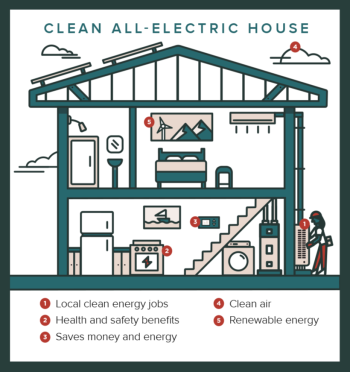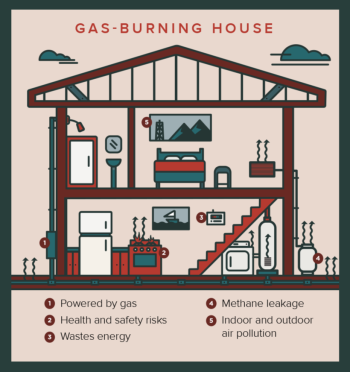RNG is Not a Climate Friendly Alternative to Fossil Gas in our Buildings or our Power Plants
We are in the midst of a climate crisis, so it makes sense to explore all options for a just transition away from fossil fuels. But in the rush to solve the crisis, we must take care not to embrace solutions that provide only limited, short-term benefits or that reinforce inequalities in our current energy system.
CenterPoint Energy, Minnesota’s largest fossil gas utility, and Xcel Energy, Minnesota’s largest electric utility and second-largest fossil gas utility, are promoting one of these false solutions: “Renewable Natural Gas” (RNG). Xcel Energy has announced plans to explore RNG for heating and cooling needs of its gas customers - and potentially for its fossil gas power plants.
CenterPoint Energy has been exploring RNG for over a year. They submitted a pilot project to the MN PUC last year that was rejected, supported legislation in the 2020 legislative session to further their efforts, and the MN PUC recently approved a proposal to allow RNG projects in MN to connect to their gas pipelines.
Pull back the greenwashed curtains, however, and it becomes clear that utility efforts to promote RNG are more about protecting company profits than reducing climate emissions.
There are cleaner, safer, and more cost-effective ways to reduce emissions, like switching the way we heat our homes and businesses from gas appliances to electric ones, called “electrification.” But gas utilities make big money from selling fossil gas and maintaining large pipelines and other infrastructure needed to deliver that gas.
Minnesota must work towards a just transition away from fossil fuels, including fossil gas, and invest in electrification where possible.
So what is “renewable natural gas?”
RNG - sometimes called biogas - consists mostly of methane extracted from landfills, or produced by anaerobic digestion of manure, sewage treatment sludge, or other biological sources. It can be used as a substitute for fossil gas, known by the fossil fuel industry that profits from it as “natural gas.”
The fossil fuel industry’s view is that RNG reduces greenhouse gas emissions by reducing the amount of fossil gas we use AND by capturing methane that would have been released into the atmosphere by the ordinary decay of biological sources.
Well that doesn’t sound so bad. Can’t we just replace all our fossil gas w/ RNG?
As with anything you hear from the fossil fuel industry, you should take this messaging with a grain of salt.
RNG is NOT the best way to cut carbon emissions in our homes and buildings for a variety of reasons: RNG is very expensive to make; the supply of biological sources is limited; the environmental benefits are mixed; and it requires continued investment in fossil fuel infrastructure.
Moreover, electrification is a cleaner and more cost effective solution for our buildings. For a thorough overview, check out the report by Sierra Club and EarthJustice on “The Myth of Renewable Natural Gas for Building Decarbonization.”
Here are the topline takeaways:
RNG is expensive: There are much less expensive alternatives to reducing climate pollution from our homes and businesses than RNG. Costs range from 4 to 17 times more expensive than fossil gas.
Electrification is better for our health. Burning gas in our homes and businesses has an impact on our health by increasing our exposure to indoor air pollutants like carbon monoxide, VOCs (volatile organic compounds), and particulate matter. This can contribute to a number of health impacts like exacerbating symptoms of asthma, COPD and heart disease. These impacts disproportionately harm people living in poverty, Black, Indigenous and People of Color, and rural residents. For more details, you can check out a report by Sierra Club and MN350 on the risks of fossil gas.
There’s not enough RNG. According to a study by the American Gas Foundation, even after ramping up production, RNG could only replace between 6-13% of total fossil gas demand. It will never be able to replace gas in homes, buildings, and power plants. Given the supply limits, continuing to build new gas infrastructure is not the right investment for decarbonization.
The supply of environmentally beneficial RNG is even smaller. There are multiple potential sources of RNG, including landfill gas, animal manure, organic food waste, and wastewater treatment plants. And both the climate and other environmental and health benefits vary significantly depending on the source.
Large polluting factory farms are the largest sources of RNG in the U.S. today. These farms have huge environmental footprints with air and water pollution in addition to methane and have environmental justice implications. The economics of RNG favor large manure concentrations, so we must ensure any RNG development does not incentivize an increase of large factory farms. RNG should also not incentivize other waste streams that could be avoided by waste reduction efforts.
RNG Requires Continued Investment In Fossil Gas during a Climate Crisis. The proposals from CenterPoint Energy so far request that RNG sources be able to interconnect to its current fossil gas pipeline system. And that system is leaky, leading to increased methane in the atmosphere. Whether the methane is synthetic, biogas, or fracked gas, if it’s pumped into homes and businesses through the existing gas distribution network it will face similar leakage rates, and ultimately have the same negative climate impacts from methane leakage into our atmosphere. Instead of continuing to invest in this infrastructure that is catastrophic to our climate, we must look at electrification as an alternative to power our homes and buildings. RNG should be properly deployed in a way that doesn’t continue investments in fossil fuel infrastructure.
Minnesota must work towards a just transition away from fossil fuels, including fossil gas. RNG is not a climate friendly alternative to fossil gas for heating and cooling our buildings. Avoiding the use of RNG for home heating and other home appliances would help to reduce known health impacts.
Electrification is a more cost effective and cleaner alternative for our homes and buildings. For more details, NRDC has a great report on biogas that digs into all of the different sources and implications. We must look to electrification, not RNG, as an alternative to fossil gas when we power our homes and heat our buildings.
OK, so is there a place for RNG?
Sustainable RNG should be directed at the hardest to electrify sectors of our economy, like certain heavy industries. RNG that is produced and used locally and not interconnected to fossil gas infrastructure will have the biggest benefit to our climate, as it would not require new pipelines or other infrastructure for transportation.
We need a better understanding of the RNG potential in MN for these hard-to-decarbonize sectors, but we must also better understand the opportunities for electrification and the negative environmental impacts of that RNG potential.
So for now, we have to say “No” to false solutions. Renewable Natural Gas is not a climate friendly alternative to fossil gas in our buildings or our power plants. We must focus on electrification, which is better for climate, health, and customers.

